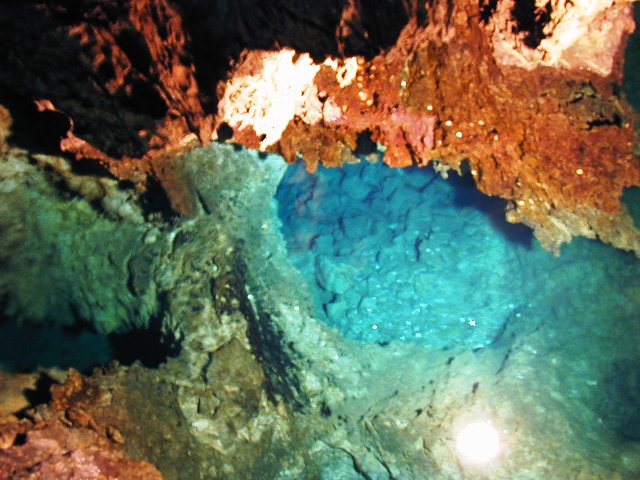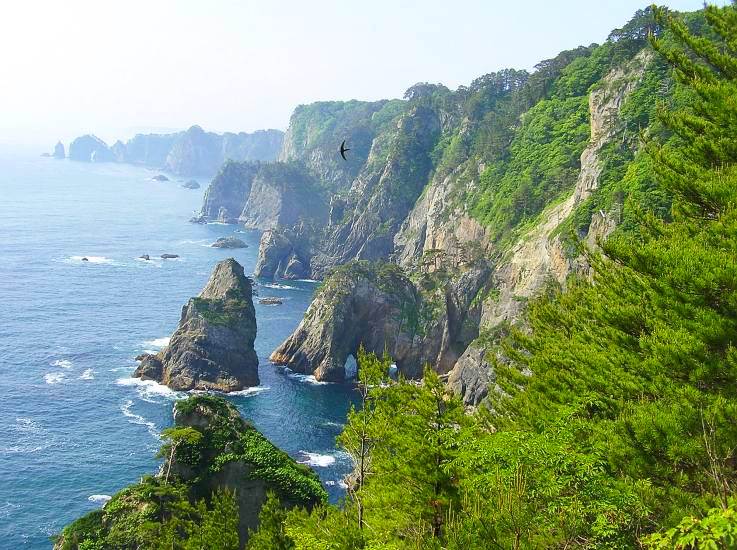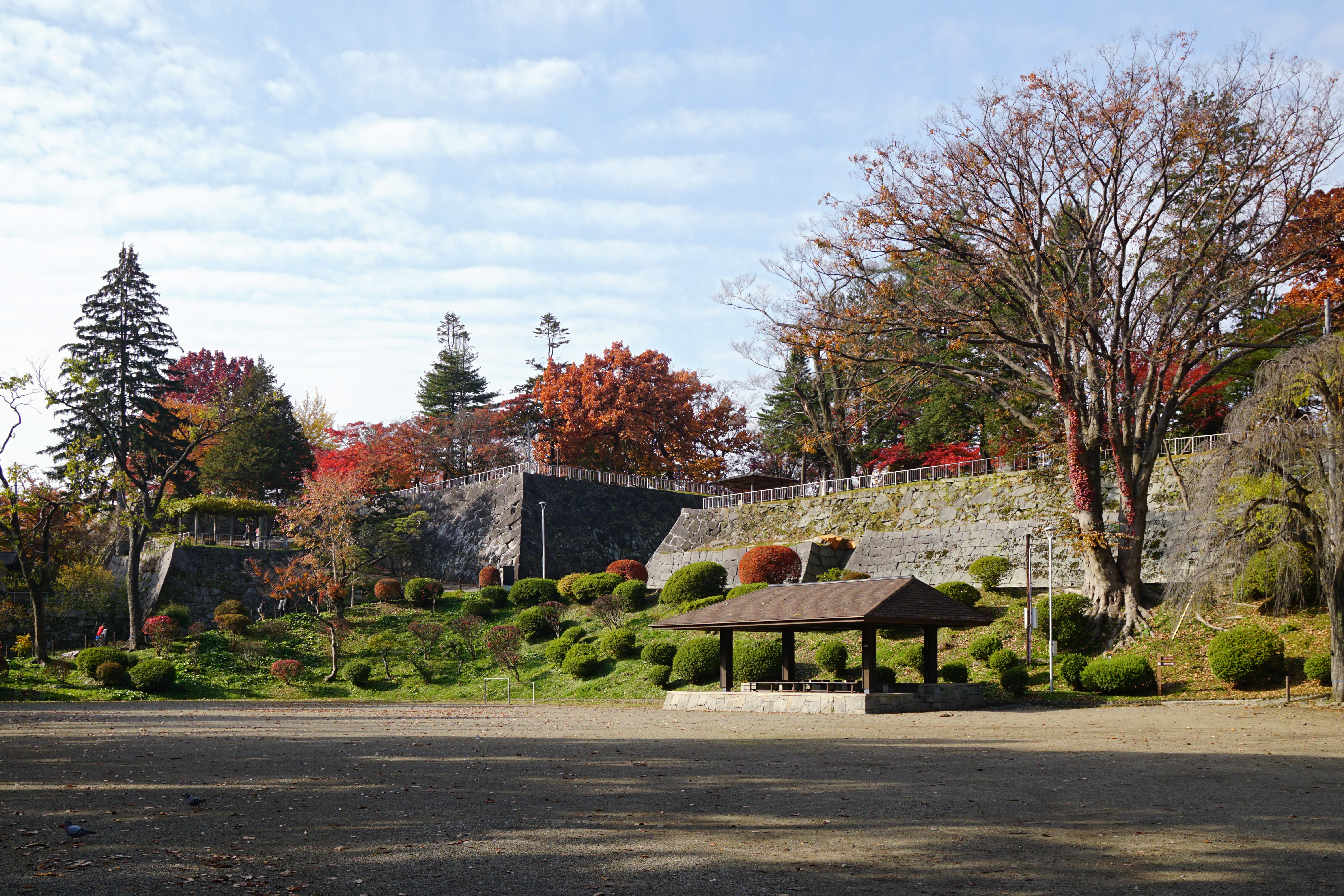|
Iwaizumi
is a town located in Iwate Prefecture, Japan. , the town had an estimated population of 8,987, and a population density of 9.1 persons per km² in 4366 households. The total area of the town is . Geography Iwaizumi is in the Kitakami Mountains of northeast Iwate prefecture, east of the prefectural capital of Morioka. It has a small coastline on the Pacific Ocean to the east. The area has numerous limestone caves, including the RyÅ«sendÅ. Neighboring municipalities Iwate Prefecture *Morioka *Kuji * Miyako * Fudai * Tanohata * Kuzumaki *Noda Climate Iwaizumi has a humid climate (Köppen climate classification ''Cfa'') characterized by mild summers and cold winters with heavy snowfall. The average annual temperature in Iwaizumi is 9.5 °C. The average annual rainfall is 1283 mm with September as the wettest month and February as the driest month. The temperatures are highest on average in August, at around 22.3 °C, and lowest in January, at around â2.0&nbs ... [...More Info...] [...Related Items...] OR: [Wikipedia] [Google] [Baidu] |
RyÅ«sendÅ
is one of Japan's three largest Solutional cave, limestone caverns. It is located in the town of Iwaizumi, Iwate, Iwaizumi, Iwate Prefecture, in the TÅhoku region of northern Japan. RyÅ«sendÅ has an accessible length of 1200 meters, making it the 62nd longest in Japan; however, its depth of from the entrance to its lowest point is the 5th deepest in Japan. The total confirmed length of the cave is currently , although the cave may extend much further. Further exploration has been banned following a fatality in December 1968. The cave system includes at least four underground lakes, the third of which has a depth of , and the fourth of which (not accessible to the public) has a depth of over . The cave system is also home to colonies of Greater horseshoe bat, Eastern long-fingered bat, Brown long-eared bat and Hilgendorf's tube-nosed bat as well as Microbats. RyÅ«sendÅ was designed a Natural monument by the Japanese government in 1934. The caves were opened to the public in 19 ... [...More Info...] [...Related Items...] OR: [Wikipedia] [Google] [Baidu] |
Iwate Prefecture
is a prefecture of Japan located in the TÅhoku region of Honshu. It is the second-largest Japanese prefecture at , with a population of 1,210,534 (as of October 1, 2020). Iwate Prefecture borders Aomori Prefecture to the north, Akita Prefecture to the west, and Miyagi Prefecture to the south. Morioka is the capital and largest city of Iwate Prefecture; other major cities include Ichinoseki, ÅshÅ«, and Hanamaki. Located on Japan's Pacific Ocean coast, Iwate Prefecture features the easternmost point of Honshu at Cape Todo, and shares the highest peaks of the Åu Mountainsâthe longest mountain range in Japanâat the border with Akita Prefecture. Iwate Prefecture is home to famous attractions such as Morioka Castle, the Buddhist temples of Hiraizumi including ChÅ«son-ji and MÅtsÅ«-ji, the Fujiwara no Sato movie lot and theme park in ÅshÅ«, and the Tenshochi park in Kitakami known for its huge, ancient cherry trees. Iwate has the lowest population density of any prefecture ... [...More Info...] [...Related Items...] OR: [Wikipedia] [Google] [Baidu] |
Shimohei District, Iwate
Map showing original extent of Shimohei District in Iwate Prefecturecolored area=original extent in Meiji period; green=present area is a rural district in Iwate Prefecture, in the TÅhoku region of northern Japan. , the district has an estimated population of 29,559 and a population density of 20 persons per km2. The total area is 1,481.02 km2. Much of the city of Miyako was formerly within the district. There are two towns and two villages within the district. *Iwaizumi *Yamada * Fudai * Tanohata History During the Edo period under the Tokugawa shogunate, the district was within Mutsu Province and was under the control of the Nanbu clan of Morioka Domain. In 1869, following the Meiji restoration, Mutsu Province was divided, with the area of Hei District becoming part of RikuchÅ« Province, and from 1872, part of Iwate Prefecture. On January 4, 1879, Hei District was divided into five districts (Kitahei, Higashihei, Nishihei, Nakahei and Minamihei. However, on April 1, 1897 ... [...More Info...] [...Related Items...] OR: [Wikipedia] [Google] [Baidu] |
Tanohata, Iwate
is a village located in Iwate Prefecture, Japan. , the village had an estimated population of 3,244, and a population density of 21 persons per km² in 1,398 households. The total area of the village is . Geography Tanohata is a coastal mountainous community situated on the rocky ria Sanriku Coast along the Pacific coast of Iwate. Parts of the village are within the borders of the Sanriku FukkŠNational Park. Neighboring municipalities Iwate Prefecture * Iwaizumi * Fudai Climate Tanohata has a cold humid climate (Köppen climate classification ''Cfa'') characterized by mild summers and cold winters. The average annual temperature in Tanohata is 10.1 °C. The average annual rainfall is 1201 mm with September as the wettest month and February as the driest month. The temperatures are highest on average in August, at around 22.6 °C, and lowest in January, at around -1.1 °C. Demographics Per Japanese census data, the population of Tanohata peaked at around ... [...More Info...] [...Related Items...] OR: [Wikipedia] [Google] [Baidu] |
Fudai, Iwate
is a village located in Iwate Prefecture, Japan. , the village had an estimated population of 2,607, and a population density of 37.4 persons per km2 in 1,126 households. The total area of the village is . Geography Fudai is a coastal mountainous community situated on the Sanriku Coast ria along the Pacific Ocean in northern Iwate. The southern part of the village, an area called , included a part of the Rikuchu Kaigan National Park, which is now part of the Sanriku FukkŠNational Park. It features an observation point to view scenic seaside cliffs. Neighboring municipalities Iwate Prefecture *Noda * Iwaizumi * Tanohata Climate Fudai has a cold humid climate (Köppen climate classification ''Cfa'') characterized by mild summers and cold winters. The average annual temperature in Fudai is 10.1 °C. The average annual rainfall is 1201 mm with September as the wettest month and February as the driest month. The temperatures are highest on average in August, at aroun ... [...More Info...] [...Related Items...] OR: [Wikipedia] [Google] [Baidu] |
Miyako, Iwate
is a city located in Iwate Prefecture, Japan. , the city had an estimated population of 51,150, and a population density of 41 persons per km2. The total area of the city is . Geography Miyako is located in central Iwate Prefecture, bordered by the Pacific Ocean to the east, with the main urban area fronting on Miyako Bay. It is located at the northern end of the rias coastal area of the Sanriku Coast, east of the prefectural capital of Morioka. The city area is the largest in Iwate Prefecture and the second largest in the TÅhoku region (after Tsuruoka, Yamagata). However, around 90% of the city area is covered by mountains and forest, so the habitable area is only about 9% of the total area, and therefore although the population density per total area is low, but the population density per habitable area exceeds the prefecture average. Miyako is connected to Morioka by an eastâwest train line and highway and the coastal highway also goes through the town. The city has a small ... [...More Info...] [...Related Items...] OR: [Wikipedia] [Google] [Baidu] |
Towns Of Japan
A town (çº; ''chÅ'' or ''machi'') is a local administrative unit in Japan. It is a local public body along with prefecture (''ken'' or other equivalents), city (''shi''), and village (''mura''). Geographically, a town is contained within a district. Note that the same word (çº; ''machi'' or ''chÅ'') is also used in names of smaller regions, usually a part of a ward in a city. This is a legacy of when smaller towns were formed on the outskirts of a city, only to eventually merge into it. Towns See also * Municipalities of Japan * Japanese addressing system The Japanese addressing system is used to identify a specific location in Japan. When written in Japanese characters, addresses start with the largest geographical entity and proceed to the most specific one. When written in Latin characters, ad ... References {{reflist External links "Large_City_System_of_Japan";_graphic_shows_towns_compared_with_other_Japanese_city_types_at_p._1_[PDF_7_of_40/nowiki>">DF_7_of_4 ... [...More Info...] [...Related Items...] OR: [Wikipedia] [Google] [Baidu] |
Noda, Iwate
is a village located in Iwate Prefecture, Japan. , the village had an estimated population of 4,201, and a population density of 52 persons per km² in 1660 households. The total area of the village is . Geography Noda is located in far northeastern Iwate Prefecture, bordered by the Pacific Ocean to the east. The western portion of the village is within the Kitakami Mountains. Parts of the coastline of Noda are within the borders of the Sanriku FukkŠNational Park. Neighboring municipalities Iwate Prefecture *Kuji * Iwaizumi * Fudai Climate Noda has a cold oceanic climate (Köppen climate classification ''Cfb'') characterized by mild summers and cold winters with heavy snowfall. The average annual temperature in Noda is 8.7 °C. The average annual rainfall is 1273 mm with September as the wettest month and February as the driest month. The temperatures are highest on average in August, at around 21.4 °C, and lowest in January, at around -2.9 °C. Demogra ... [...More Info...] [...Related Items...] OR: [Wikipedia] [Google] [Baidu] |
Kuzumaki, Iwate
is a town located in Iwate Prefecture, Japan. , the town had an estimated population of 5,632, and a population density of 13 persons per km². The total area of the town is . The town uses many alternative energy sources, producing a surplus of energy, including wind power and biomass. Geography Kuzumaki is located in a basin in north-central Iwate Prefecture with an average elevation of 400 meters, surrounded by the 1000 meter mountains of the Kitakami Mountains. Approximately 60% of the town area is mountains and forests. The Mabechi River flows through the town. Neighboring municipalities Iwate Prefecture *Morioka *Kuji * Iwate * Iwaizumi * Kunohe * Ichinohe Climate Kuzumaki has a humid continental climate (Köppen climate classification ''Dfb'') characterized by mild summers and cold winters. The average annual temperature in Kuzumaki is 7.0 °C. The average annual rainfall is 1434 mm with September as the wettest month and February as the driest month. The tempe ... [...More Info...] [...Related Items...] OR: [Wikipedia] [Google] [Baidu] |
Kuji, Iwate
is a Japanese city in Iwate Prefecture. , the city had an estimated population of 34,418 in 15,675 households, and a population density of 55 persons per km2. The total area of the city is . Geography Kuji is in far northeastern Iwate Prefecture, bordered by the Pacific Ocean to the east. Most of the inland areas of the city are within the Kitakami Mountains. Portions of the coastline of Kuji are within the borders of the Sanriku FukkŠNational Park. Neighboring municipalities Iwate Prefecture * Karumai * Kunohe * Hirono *Noda * Kuzumaki * Iwaizumi Climate Kuji has a humid climate (Köppen climate classification ''Cfa''), characterized by mild summers and cool winters. The average annual temperature in Kuji is 9.7 °C. The average annual rainfall is 1176 mm with September as the wettest month and February as the driest month. The temperatures are highest on average in August, at around 22.5 °C, and lowest in January, at around -1.9 °C. Demographic ... [...More Info...] [...Related Items...] OR: [Wikipedia] [Google] [Baidu] |
Morioka, Iwate
is the capital city of Iwate Prefecture located in the TÅhoku region of northern Japan. On 1 February 2021, the city had an estimated population of 290,700 in 132,719 households, and a population density of . The total area of the city is . Geography Morioka is located in the in central Iwate Prefecture, at the confluence of three rivers, the Kitakami, the Shizukuishi and the Nakatsu. The Kitakami River is the second largest river on the Pacific side of Japan (after the Tone River) and the longest in the TÅhoku region. It runs through the city from north to south and has a number of dams within the city boundaries, including the ShijÅ«shida Dam and GandÅ Dam. An active volcano, Mount Iwate, dominates the view to the northwest of the city. Mount Himekami is to the north and Mount Hayachine can sometimes be seen to the southeast. Surrounding municipalities Iwate Prefecture *Hanamaki * Hachimantai * Takizawa * Miyako *Shizukuishi * Kuzumaki * Shiwa *Yahaba * Iwaizumi Demogr ... [...More Info...] [...Related Items...] OR: [Wikipedia] [Google] [Baidu] |
Edo Period
The or is the period between 1603 and 1867 in the history of Japan, when Japan was under the rule of the Tokugawa shogunate and the country's 300 regional '' daimyo''. Emerging from the chaos of the Sengoku period, the Edo period was characterized by economic growth, strict social order, isolationist foreign policies, a stable population, perpetual peace, and popular enjoyment of arts and culture. The period derives its name from Edo (now Tokyo), where on March 24, 1603, the shogunate was officially established by Tokugawa Ieyasu. The period came to an end with the Meiji Restoration and the Boshin War, which restored imperial rule to Japan. Consolidation of the shogunate The Edo period or Tokugawa period is the period between 1603 and 1867 in the history of Japan, when Japan was under the rule of the Tokugawa shogunate and the country's regional '' daimyo''. A revolution took place from the time of the Kamakura shogunate, which existed with the TennÅ's court, to the Tok ... [...More Info...] [...Related Items...] OR: [Wikipedia] [Google] [Baidu] |







